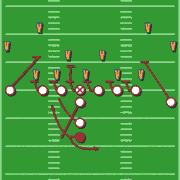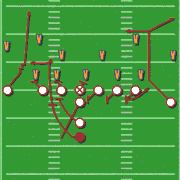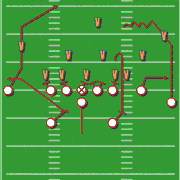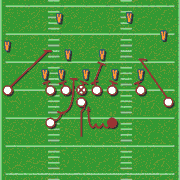Article CategoriesAFM Magazine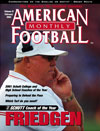
|
Attacking Modern Day Defenses with the Pass and Run.by: Sparky WoodsOffensive Coordinator, Mississippi State © More from this issue Two things defenses agree on these days are making the offenses one-dimensional by stopping the run and forcing the quarterback to execute under tremendous pressure. They play mostly man coverage (at least on the corners) and place more defenders near the line of scrimmage than the offense has blockers to block for the run. Placing their defenders near the line of scrimmage puts them in position to rush the quarterback in passing situations. Once again they have the option of rushing more defenders than the offense has potential blockers. Buddy Ryan, while at the Chicago Bears, taught all of us that the defense has one more player than the offense does because the offense has the ball to deal with. One cannot block while he has the ball in his hands. Even though sacking the quarterback would be the defense’s goal, putting pressure and punishing the quarterback would be acceptable to the defense’s plan. In addition, the quarterback has potential problems with execution because of the pressure of the twenty-five second clock and increased pressure by television to shorten the game. Along with this pressure is the possibility of tremendous crowd noise that can make communication very difficult to say the least. Because of these factors, a great number of teams have almost given up trying to run the ball or have decided to run the ball with the quarterback either by using more option plays or by using him as a tailback. We want to continue to run the ball because we want to be a physical football team and believe we must be able to give our lineman a chance to come off the ball in a physical manner. I believe it is unfair to ask the lineman to play backing up all the time. We also want to give the ball to our best runner with a lead blocker in front of him. Our approach is to continue to make the game a physical one. It is understood that football is about blocking and tackling. However, we emphasize tackling and avoiding being tacked as the main factor in the game. Our defense puts a huge emphasis on tackling and we want guys who are capable of breaking tackles and making the defenders miss. Our goal is to force the defense to execute to stop us from running the ball. We want to be determined to run but not to the point of being stubborn. We respect the defense’s ability and understand the math of more tacklers than blockers. Therefore, we want to look for opportunities to run when the defense is in more of a coverage position and the math evens out. While running the ball is obviously important to us, we realize that we must be equally committed to throwing the football. The offense must be able to execute both the run and the pass under the pressure that modern day defenses bring to the game. Execution has to start with protections and the ability to win quickly in one on one situations, then finish by escaping the tackles and gaining additional yardage. Normal downs consist of situations where the defense believes the offense is equally likely to run or pass. In normal down situations, we most often choose to align in a formation such as an “I” formation with two wide receivers. This prepares us to run with power or simulate a run with a play action pass. It is especially beneficial when we can couple the two together and run or pass according to the approach of the defense. An example of a good play choice in this situation is the lead play to the open-end side of the formation. (See Diagram 1)
The quarterback must decide and communicate run
or pass at the line of scrimmage. A positive point about this combination
is that almost always the blocking responsibilities are the same
for both plays. The playside tackle will block the defensive end.
He just waits to find out of he is blocking for the run or the pass.
Play action passing is good on normal downs when the defense is
determined to eliminate the run.
Notice the blocking responsibilities are the same except for the
slot receiver who now acquires responsibility for the halfback’s
man so the halfback can carry the ball. Again, the quarterback must
decide and communicate pass or run at the line of scrimmage. The
other members of the team just want to know if they block their
defenders for the pass or the run. The important coaching point
on this combination is to make it look and sound like pass. On the
draw play we want to simulate a pass before we attack the defender.
Pass action runs are good on conversion downs when the defense is
determined to outnumber and cover the pass. Quick release passes
are good when the defense is committed to pressure, either when
the plan is to rush more defenders than the offense has blockers.
|
|
| HOME |
MAGAZINE |
SUBSCRIBE | ONLINE COLUMNISTS | COACHING VIDEOS |
Copyright 2024, AmericanFootballMonthly.com
All Rights Reserved


